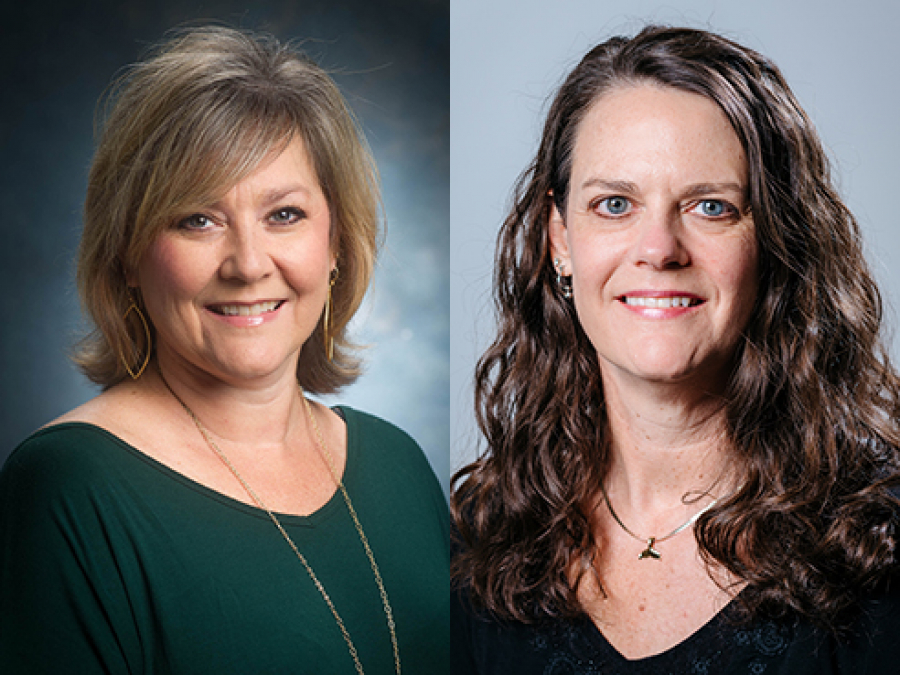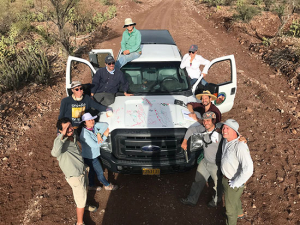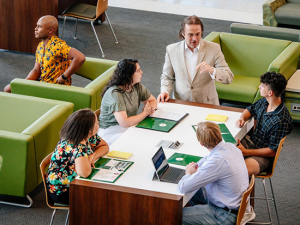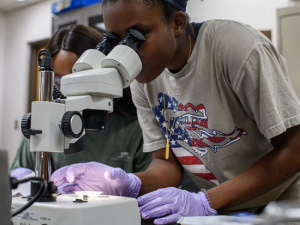 All Carmel McNicholas-Bevensee, Ph.D., asked the Riverchase Elementary School fifth graders was one question.
All Carmel McNicholas-Bevensee, Ph.D., asked the Riverchase Elementary School fifth graders was one question.
What was your favorite part?
The answers were varied.
“I liked the stethoscope,” said one. “The pig thing — the heart,” said another. “I liked the blood pressure cuff.” “My favorite was seeing how all of the parts fit together inside the body.”
Welcome to the PhUn — or at least an extension of it.
UAB’s Department of Cell, Developmental and Integrative Biology recently spent several days at Riverchase Elementary School as part of an outreach program sponsored by the American Physiological Society. This outreach endeavor, which is related to Physiology Understanding (PhUn) Week held each November, engages children from kindergarten to fifth grade in a variety of hands-on activities aimed at teaching them about the pulmonary, cardiovascular and gastrointestinal systems.
Activities also focus on teaching how important it is to keep healthy with regular exercise and a proper diet and the dangers of tobacco products.
The 3-year-old outreach program will reach a record 1,600 students this year at Deer Valley Elementary, Blountsville Elementary, Greenwood Elementary, Riverchase Elementary and Brock’s Gap Intermediate thanks to materials and funding provided by UAB’s Community Outreach and Development (CORD) and Pulmonary Injury and Repair Centers and a grant awarded to Bevensee from the American Society of Biochemistry and Molecular Biology HOPES Stem Award.
| The 3-year-old outreach program will reach a record 1,600 students this year at Deer Valley Elementary, Blountsville Elementary, Greenwood Elementary, Riverchase Elementary and Brock’s Gap Intermediate thanks to materials and funding provided by UAB’s Community Outreach and Development (CORD) and Pulmonary Injury and Repair Centers and a grant awarded to Bevensee from the American Society of Biochemistry and Molecular Biology HOPES Stem Award. |
“We reached 200 children when we started this program three years ago, so it has grown very quickly,” says Bevensee, instructor of Cell, Developmental and Integrative Biology. “We’ve spent a lot of time in Hoover schools, but with the additional funding this year we had the opportunity to expand our program. We’ve been to Blount County and we will return to Greenwood Elementary in Bessemer April 22. It’s amazing how fast the program has grown, and we have interest from other schools.”
Interactive learning
UAB students — including undergraduates, medical students, graduate students and post-docs — along with physicians, faculty and even retired faculty all volunteer their time to help teach students in an effort to get them excited about health and science. UAB facilitators design age-appropriate tasks, and the students participate in hands-on activities.
Students have an opportunity to dress like a scientist, touch and see cow and pig hearts, inflate pig lungs, look at lung and heart tissue under a microscope, construct anatomical models of the chest and stomach and view complete gastrointestinal tracts and pieces of esophagus with a magnifying glass.
 The additional funding provided by the HOPES Stem Award and the Pulmonary Injury and Repair Center, directed by Sadis Matalon, Ph.D., Dr.Sc. (Hon.), enabled Bevensee to purchase necessary supplies, as well as the anatomical models, blood pressure equipment, stethoscopes, pulse oximeters and computer equipment to aid in presenting.
The additional funding provided by the HOPES Stem Award and the Pulmonary Injury and Repair Center, directed by Sadis Matalon, Ph.D., Dr.Sc. (Hon.), enabled Bevensee to purchase necessary supplies, as well as the anatomical models, blood pressure equipment, stethoscopes, pulse oximeters and computer equipment to aid in presenting.
“Children can really take part in these exercises in an active, hands-on way,” Bevensee says. “It’s even more interactive now, and we’re totally self-sufficient. We don’t need the schools we visit to provide us anything other than the space.”
Cindy Stone, who has a son in third grade at Riverchase Elementary, volunteered to help the school’s teachers and UAB’s representatives in the classroom. She said UAB’s presenters were “impressive,” and that the children were engaged in the exercises right from the beginning.
“You can see the kids really respond, and I think it’s because it’s so hands on,” Stone said. “I can see where doing these activities can make an impression and make the children think, ‘I want to do something in the field of science.’”
Importance of good health
Children also spend part of the time learning about the importance of exercise to their overall health and how what they put in their bodies affects them.
They review the food pyramid, discuss the negative consequences of sugary drinks, how the food and drinks they eat can bring on diabetes and the dangers of smoking.
Bevensee shows a video of the differences between healthy lungs and a smoker’s lungs. Students marveled at the discoloration of the smoker’s lungs and noticed how those organs did not work as well as their non-smoking counterparts.
 The children also had an opportunity to smell the chemicals that smoking places into the body. The odor had some of them coughing and left quite an impression on a group of fifth graders.
The children also had an opportunity to smell the chemicals that smoking places into the body. The odor had some of them coughing and left quite an impression on a group of fifth graders.
“These types of activities have a chance to make a positive impact,” says J.J. Price, a second-year UAB medical student who volunteered to teach the children about the function of the lungs. “If just one of these kids doesn’t start smoking because of what they see here, then we’ve given them a chance at a healthier life.”
The gooey parts
The students are given some small goody items for participating, and materials on nutrition and smoking are sent home with them. Bevensee says these items aid in fostering conversation at home and in promoting UAB as a place that can help area families.
“The children really seem to enjoy this opportunity — especially the gooey parts when they get to touch the organs,” Bevensee says. “And this is a tremendous chance to educate them on how their bodies function and how they thrive. If we can help carry that conversation home, it helps every one.”










































